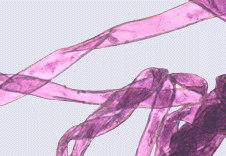|
|
|
|
|
Cotton is a part of daily life. Half of the world's textiles today are made of cotton. It is the most important fiber plant in the world. In a strict anatomical sense, the "fiber" of a cotton seed is not really a fiber at all because it is not lignified nor does it occur in the appropriate part of the plant to be called a fiber. The proper anatomical cell name for the seed "fiber" is a trichome. However, we will adopt the term "fiber" to describe the long hairs on the cotton seed as that is the commonly used term. |

|
|
|
"Fiber" Compostion
As the boll grows, the "fibers" are maturing within. In about four months times the boll begins to slit open and the "fibers" are exposed. Each seed has about 10,000 to 20,000 "fibers". The boll matures and the "fibers" lose their water and die. Each "fiber" collapses and appears as a flattened twisted tube. The degree of twist is a result of the type of environment the plant is grown in, the specific species or cultivar, and the ripeness of the "fibers". Unripe "fibers" have thin walls and lack twists. these are known as dead cotton and have little value. The twists cause the "fibers" to cling to each other and improve their spinning qualities. The Components of the cotton seed hairs are as follows: 90% Cellulose 7%-8% water 0.4% wax and oil 0.6% nitrogenous matter 1% mineral matter There are many uses for each part of the boll. Cotton seeds are used for various commercial products. The oil is pressed out of them and used for salad oil, margarine, soaps, and cosmetics. The lint hairs of the cotton can be spun into thread for making cloth. The fuzz hairs are used to make cotton bathing, rayon, and types of plastic, among other products. Temperature is the greatest deterrent to optimum fiber development. Studies were done growing cotton under progressively lower seasonal temperastues. Many qualities in the cotton decreased including: percent cellulose, degree of polymerization, crystallinity, and strength. Many people have their own theories on improving the quality of cotton. Some believe setting the fibers in the sun and storing them before ginning improves the quality. Also the first boll on the plant usually is eliminated due to poor fibers. |
|
Introduction | Flowers&Fruit | Roots | Stems | Leaves Section of Plant Biology Division of Biological Sciences UNIVERSITY OF CALIFORNIA, DAVIS |